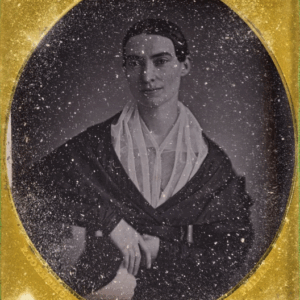JTF (just the facts): A total of 25 black and white and color photographs (including 3 diptychs), framed in white and unmatted, and hung against white walls in the main gallery space. All of the works are archival pigment prints, made in 2015 and 2016 and printed in 2017. Physical sizes include 17×17 (both single images and 2 panel diptychs), 25×25, and 43×43, with editions sizes of 5+1AP for the two smaller sizes and 3+1AP for the largest size. The show also includes a two-channel film, on view in a darkened room. A monograph of this body of work was published in 2017 by b.frank books (here). (Installation shots below.)
Comments/Context: In Marianna Rothen’s first photobook, Snow and Rose & other tales, she constructed a richly resonant dream world where empowered women were free to be themselves in an environment entirely without men. Starting with an anxious woman in a wedding dress who ultimately flees, the fragments of visual narrative went on to capture various women frolicking nude in the forest, playfully lounging in old houses, reading books, taking baths, having tea parties, and generally enjoying the loose openness of female companionship. Shot and styled with a retro look and feel, and full of flouncy wigs, the images reveled in natural unselfconscious nudity and contagious smiling confidence.
Shadows in Paradise is Rothen’s second show and book, and its apt title lets us know that we will not be in for a continuation of the easy going, girlfriend sleepover good times. In a series of six open-ended multi-image vignettes, Rothen builds up a subtly different mood, where uncertainty and insecurity reenter the psychological terrain and introspection takes hold. Gone are the laughing eyes and the teasing prancing, replaced by head-in-hands despair, wide eyed fear, and weary leaning-on-the-doorframe pensiveness.
Given that Rothen herself is a character in some of her stories, and the care with which costumes and female personas are created and employed, it’s hard not to make connections back to Cindy Sherman’s work, particularly the Untitled Film Stills and their meticulously controlled cinematic moments. Other contemporary photographers, like Alex Prager and Julia Fullerton-Batten, have also leveraged Sherman, putting females in stylized situations of peril and distress, sometimes with a healthy dose of film noir cool.
Where Rothen has carved out something durably different is in the softness of her touch – while others have often opted for brassy bold color exaggeration in their girl-on-the run stories, even when Rothen has pushed toward Hitchockian suspense and melodrama in her staging, her tones and shadows have muted those blasts of high-intensity emotion, bringing them back toward more realistic roots. The wigs and setups never let us forget we’re inhabiting the artist’s imagination, but the decaying house, the natural light, and the lost-in-thought gazes seduce us into temporarily suspending our disbelief.
While Rothen’s women still inhabit an all-female domain (with a handful of men interrupting from book jackets, posters, and framed pictures), there is much more implied tension in these new pictures. Pregnant bellies, overturned baby carriages, stubbed out cigarettes, and empty whiskey bottles are the props that lead us to darker conclusions, and a few brandished knives and handguns take the threatened atmosphere further. We voyeuristically watch as the scenarios start to unravel, peering through a broken window pane or the folds of a curtain, or catching our heroines unaware in mirror reflections or through open doors.
Rothen’s management of body language and facial expression is a consistent superlative in her photographs. Crossed arms provide a small bit of protection from an unseen force, feet up on the dining room table imply casual, don’t-care-anymore resignation, and a swayed look underneath a chandelier pulls with teetering imbalance. More complex double mirror reflections and side-by-side diptychs (with blonde/brunette Betty and Veronica wigs) demonstrate that Rothen has been storyboarding these scenes out with precision, alternately using black and white and color to heighten the particular mood of her pictures. A deer-in-the headlights held wineglass, a downcast look under a veil, a sunglassed sway in a fur robe, each pose hits its stylistic mark with elegant exactness.
As a pair, Rothen’s two bodies of work provide a smart contrast of light and dark, where the realities and perils of life ultimately intrude on the idyllic freedoms of the original setting. That she can so effortlessly move back and forth between the nuances of liberation and constraint is proof that she is much more than a young photographer playing with dated wigs. Her new images introduce the friction of a richer spectrum of emotions, and that undercurrent of faded illusion gives the best of her photographs a sense of uncertain vulnerability.
Collector’s POV: The works in this show are priced between $2000 and $4500, based on size, with the film available for $6000. Rothen’s work has little secondary market history at this point, so gallery retail remains the best option for those collectors interested in following up.



















